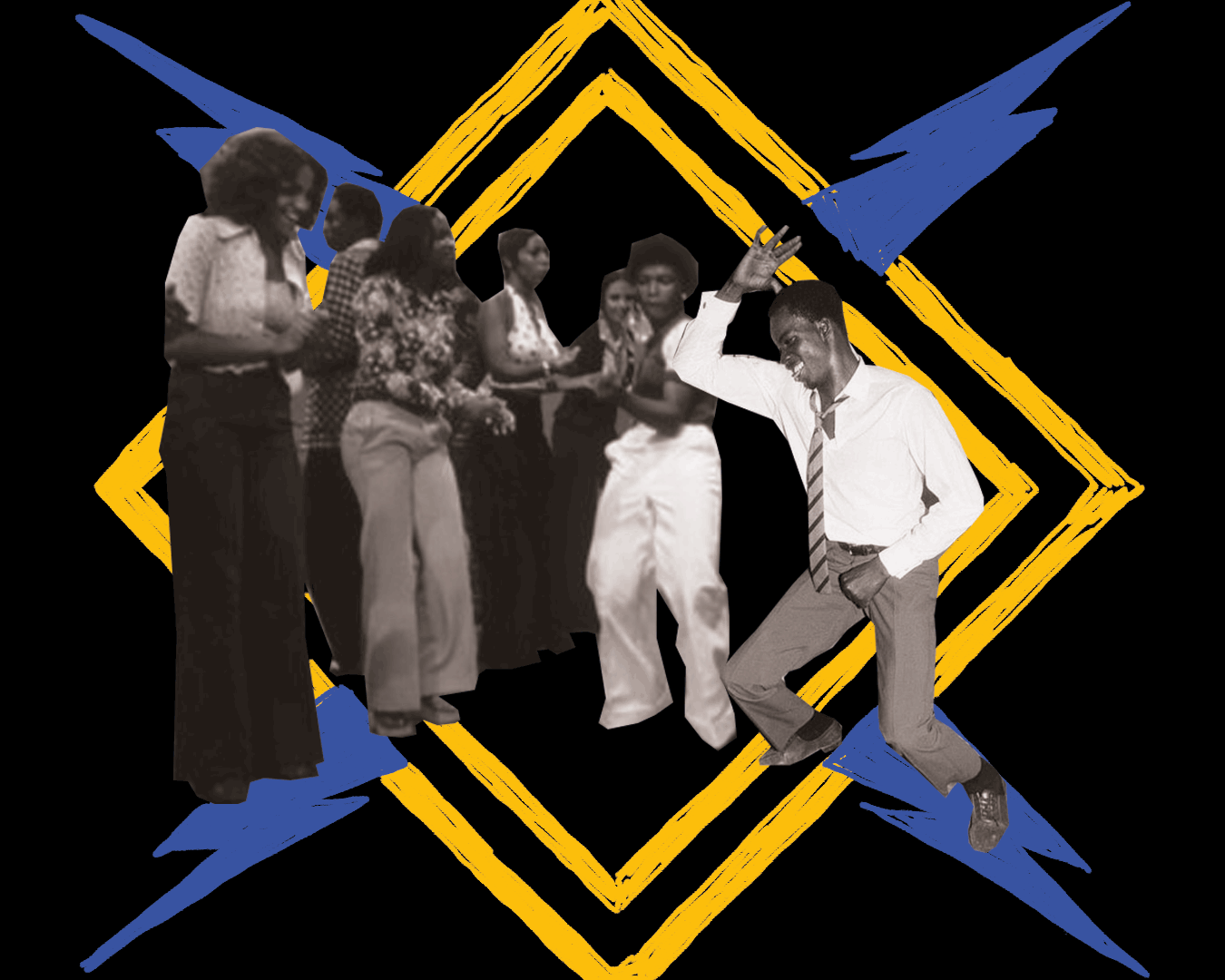
Collage and illustration by Bruna Borges
[ID: A black and white collage with a man dancing down on the right, in the middle there is a woman dancing, on the left there are some women looking at them. In the back, there is an animated illustration in blue and yellow showing movement.]

[ID: Aries Jordan is a Black woman with a short curly afro. She is smiling and looking at the camera. The background includes a blurred view of The Oakland Museum. She is wearing an open blue blazer with a yellow shirt. Her hand is on her hip.]
I’m not from a dancing family! But some of the most iconic family memories have come through dance, particularly the Soul Train Line. Like the time Granny almost fell while doing her infamous “Twist”, or the time when my reluctant uncle who rarely attends family events went into his Michael Jackson bag and to our delight gave us some thriller moves. Then there is the newest lil’ addition to our family who is cheered on and ushered down the line for simply walking. One cannot forget the family member that is known for their dancing filled with technique, choreographed moves and even rare dance moves brought out only to declare a dance off when another dancer has joined the line.
The Soul Train Line comes from the popular syndicated weekly show “Soul Train” that began in the 1970s and lasted thru the early 2000s. Soul Train featured Black musicians and most notably dancers that captivated audiences as they made their way down the Soul Train Line. What began as a way to end the show evolved into an essential part of Black cultural celebrations bringing people of all ages and abilities center stage. My family was no different and though we rarely broke out in dance, on cue someone would yell out “Let’s do the Soul Train Line.” Effortlessly the parallel lines were formed, the bravest went to the front and it naturally ended; something I thought innately everyone knew. But after countless failed attempts at social gatherings by someone trying to get the party started. I have come to realize the Do’s and Don’ts of the Soul Train Line in group settings need to be explained.
Get in formation and stay in it: Parallel lines are essential to a successful Soul Train Line! There should be enough space where someone is able to bust a move without busting someone in the head. This is not the Conga Line, wait until the person has reached the end of the line before you start. Unlike circle dances where someone is in the middle and onlookers and dancers alike fight to get to the center. The parallel lines allow everyone to see and be seen.
Move authentically: The Soul Train Line is your moment to shine; Do the dance you finally mastered in private. Feel the beat and work with what you got. I will never forget an event where a woman dropped it low and swung her cane in the air #toptier. Know thyself and determine your comfort level from the sidelines. If the idea of everyone looking at you while you’re dancing causes instant panic, it’s best to stay at the end of the line and high five people.
Do the most, it is expected: It is mandatory that you show out with old school moves and dances associated with the song playing. Then there are partner dances like “The Bump” or ” Kid and Play.” These dances can be tricky and require coordination and finesse. If done correctly you and your dancing partner will definitely wow the crowd.
Don’t skip the line: Now this is very important depending on how turnt up the group is, this might save your life. Whatever you do, don’t skip the line. Your turn will come, I promise. The only exception to this rule is if someone isn’t ready to go down the line and tells you to go in front of them.
Do not repeat dance moves: Unless you’re going to up the ante, don’t repeat moves someone else has done. The Soul Train Line is all about creativity, nostalgia, and originality. No one wants to see the same moves over and over. If you must repeat a move, put some stank on it, add razzle dazzle or something extra.
Keep it moving, literally: The Soul Train Line is a conveyor belt of movement and good times. Don’t stay in the same spot. The goal is to get everyone to the front and down the line. I have seen the epic fail of the Soul Train Line simply because people stopped moving. If you’re scared or changed your mind it’s okay to just step out of the line to keep the train moving.
If you find yourself in this, now rare, group dance, no excuses you know what to do!
This article appeared in the Spring 2023 issue of In Dance.


